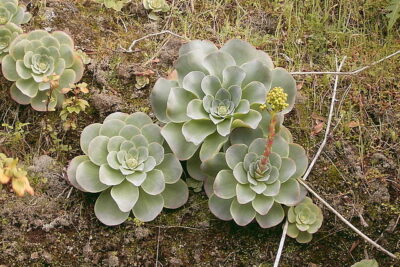
Can Painted Lady Succulents Thrive Indoors?

The popularity of succulents has soared in recent years, with their unique shapes, vibrant colors, and low-maintenance care making them a favorite among plant enthusiasts. One particular variety that has caught the attention of many is the Painted Lady succulent. Known for its striking, colorful leaves that resemble a painter's palette, the Painted Lady succulent has become a sought-after addition to indoor gardens. However, the question remains: can these beautiful succulents thrive indoors?
We will explore the characteristics of Painted Lady succulents and their ability to thrive in indoor environments. We will discuss the ideal conditions for their growth, including lighting, temperature, and watering requirements. Additionally, we will provide tips and tricks for successfully caring for Painted Lady succulents, as well as common challenges that may arise. By the end of this article, you will have a better understanding of whether Painted Lady succulents are suitable for indoor cultivation and how to ensure their well-being.
- Yes, painted lady succulents can thrive indoors with proper care
- Place painted lady succulents near a sunny window to provide adequate sunlight
- Water painted lady succulents sparingly, allowing the soil to dry out between waterings
- Use a well-draining soil mix specifically designed for succulents
- Avoid overwatering painted lady succulents to prevent root rot
- Provide good air circulation by placing a fan near the succulents
- Fertilize painted lady succulents with a balanced succulent fertilizer during the growing season
- Monitor for pests such as mealybugs or spider mites and take appropriate measures if necessary
- Prune any leggy or stretched growth to promote a compact and bushy shape
- Rotate the succulents periodically to ensure even growth and prevent leaning towards the light source
- Frequently Asked Questions
Yes, painted lady succulents can thrive indoors with proper care
If you're a succulent enthusiast, you've probably come across the stunning painted lady succulents at some point. These unique plants, also known as Echeveria derenbergii, are known for their vibrant and eye-catching colors, making them a popular choice among succulent lovers.
While painted lady succulents are typically found in outdoor gardens, they can also thrive indoors with the right conditions and care. In fact, growing them indoors allows you to enjoy their beauty up close all year round.
Here are some tips to help your painted lady succulents thrive indoors:
- Provide ample sunlight: Painted lady succulents require bright, indirect sunlight to thrive. Place them near a south-facing window or provide them with supplemental grow lights to ensure they receive at least 6 hours of sunlight per day.
- Choose the right soil: Use a well-draining succulent potting mix to prevent waterlogged roots. This will help prevent root rot, which is a common issue in succulents.
- Water sparingly: Like most succulents, painted lady succulents prefer infrequent watering. Allow the soil to dry out completely between waterings, and be cautious not to overwater, as this can lead to root rot.
- Maintain proper humidity: Painted lady succulents thrive in low humidity environments. If you live in a humid area, ensure proper air circulation around the plants to prevent excess moisture buildup.
- Provide adequate air circulation: Good air circulation is essential for painted lady succulents, as it helps prevent pest infestations and promotes healthy growth. Consider using a small fan to create gentle air movement around the plants.
- Fertilize sparingly: While painted lady succulents don't require frequent fertilization, you can use a diluted succulent fertilizer during the growing season to provide them with essential nutrients. Follow the manufacturer's instructions for proper application.
By following these guidelines, you can create the ideal environment for your painted lady succulents to thrive indoors. With their striking colors and unique rosette-shaped leaves, these succulents are sure to add a touch of beauty to any indoor space.
Place painted lady succulents near a sunny window to provide adequate sunlight
Painted lady succulents, also known as Echeveria derenbergii, are stunning plants that can add a touch of elegance to any indoor space. However, in order for these succulents to thrive indoors, it is crucial to provide them with adequate sunlight.
 Low-Light Succulents: Thriving Office Desk Plants Without Windows
Low-Light Succulents: Thriving Office Desk Plants Without WindowsWhy sunlight is important for painted lady succulents?
Sunlight is essential for the growth and development of painted lady succulents. These plants are native to desert regions, where they receive bright and direct sunlight for several hours a day. When kept indoors, it is important to mimic this natural environment as closely as possible.
How to provide adequate sunlight for painted lady succulents indoors?
The key to ensuring that painted lady succulents receive enough sunlight indoors is to place them near a sunny window. Choose a window that receives at least 4-6 hours of direct sunlight each day. South-facing windows are usually the best option, as they tend to receive the most sunlight throughout the day.
What if I don't have a sunny window?
If you don't have a sunny window available, you can still grow painted lady succulents indoors. In this case, you might need to supplement their sunlight requirements with artificial lighting. Invest in a full-spectrum grow light that emits a similar spectrum of light as the sun.
How to care for painted lady succulents near a sunny window?
 Tips for Growing Succulents Indoors in Low Light Conditions
Tips for Growing Succulents Indoors in Low Light ConditionsWhen placing painted lady succulents near a sunny window, it is important to monitor their sunlight exposure. Make sure they are not exposed to intense and direct sunlight for prolonged periods, as this can lead to sunburn and damage the leaves. If necessary, provide some shade during the hottest part of the day.
- Rotate the succulent regularly to ensure even growth and prevent it from leaning towards the light source.
- Water the plant only when the top inch of the soil feels dry, as overwatering can cause root rot.
- Use a well-draining soil mix specifically formulated for succulents to prevent waterlogging.
- Avoid placing the succulent near drafts or heating/cooling vents, as these can create fluctuations in temperature and humidity.
- Consider using a humidity tray or misting the leaves occasionally to provide some moisture in dry indoor environments.
Painted lady succulents can thrive indoors if provided with adequate sunlight. Placing them near a sunny window or supplementing with artificial lighting can help ensure their growth and overall health. Remember to monitor their sunlight exposure and provide appropriate care to keep these beautiful succulents flourishing in your indoor space.
Water painted lady succulents sparingly, allowing the soil to dry out between waterings
Painted Lady succulents, also known as Echeveria derenbergii, are popular among succulent enthusiasts for their stunning pink and green rosettes. While these plants are typically grown outdoors in gardens or containers, many people wonder if they can thrive indoors as well. In this article, we will explore whether painted lady succulents can be successfully grown indoors and provide some tips for their care.
Watering painted lady succulents indoors
When it comes to watering painted lady succulents, less is more. These plants are adapted to survive in arid conditions and have low water needs. Overwatering can lead to root rot and ultimately kill the plant. Therefore, it is crucial to water painted lady succulents sparingly and allow the soil to dry out between waterings.
As a general rule of thumb, water the plant only when the top inch of the soil feels dry. When watering, make sure to thoroughly saturate the soil and allow any excess water to drain out. Avoid leaving the plant sitting in standing water as it can promote root rot.
Providing adequate sunlight
Painted lady succulents thrive in bright, indirect sunlight. When growing them indoors, it is essential to place them near a window that receives bright, filtered light. Avoid exposing the plants to direct sunlight for extended periods as it can scorch their leaves.
If your indoor space does not receive sufficient sunlight, you can supplement it with artificial grow lights. Place the grow lights a few inches above the plants and provide them with 10-12 hours of light per day. This will help ensure that your painted lady succulents receive the necessary light for healthy growth.
 Can Succulent Plants Survive Outside Year-Round?
Can Succulent Plants Survive Outside Year-Round?Choosing the right pot and soil
When selecting a pot for your painted lady succulent, opt for a container with drainage holes. This will prevent water from pooling at the bottom and causing root rot. Additionally, using well-draining soil is crucial for the plant's overall health.
A suitable soil mix for painted lady succulents consists of a combination of potting soil and perlite or sand. This mixture provides excellent drainage and prevents the soil from becoming waterlogged. Avoid using regular garden soil as it tends to retain too much moisture, which can be detrimental to succulents.
Maintaining the right temperature and humidity
Painted lady succulents prefer temperatures between 60-75°F (15-24°C). They are not frost-tolerant and should be protected from extreme cold or hot temperatures. Indoor environments generally provide suitable temperatures for these plants.
As for humidity, painted lady succulents thrive in low humidity conditions. They are well-adapted to dry environments and do not require high levels of moisture. Avoid placing them near humidifiers or in areas with excessive moisture, as it can lead to fungal diseases.
Fertilizing and general care
Painted lady succulents are not heavy feeders and do not require frequent fertilization. During the active growing season, which is typically spring and summer, you can fertilize your plant once a month using a balanced, diluted succulent fertilizer.
However, it is important to remember that succulents are sensitive to over-fertilization. Always follow the instructions on the fertilizer packaging and avoid applying too much. Over-fertilization can lead to weak growth and damage the plant.
By following these care tips, you can successfully grow painted lady succulents indoors and enjoy their unique beauty. Remember to provide them with the right amount of water, sunlight, and well-draining soil, and they will thrive in your indoor space.
 Revamp Your Indoor Succulent Garden with Grow Lights: Before and After
Revamp Your Indoor Succulent Garden with Grow Lights: Before and AfterUse a well-draining soil mix specifically designed for succulents
When it comes to growing painted lady succulents indoors, one of the most important considerations is the type of soil you use. These succulents thrive in well-draining soil that allows excess water to flow out easily. Using a soil mix specifically designed for succulents is highly recommended, as it provides the right balance of nutrients and drainage.
A good succulent soil mix usually consists of a combination of materials such as sand, perlite, and peat moss. These components help to create a light and airy texture that promotes proper drainage and prevents the roots from sitting in water. It's important to note that regular potting soil is not suitable for painted lady succulents, as it tends to retain too much moisture and can lead to root rot.
When potting your painted lady succulents, make sure to choose a pot with drainage holes at the bottom. This will allow excess water to escape and prevent waterlogged soil. Additionally, consider adding a layer of small stones or gravel at the bottom of the pot to further enhance drainage.
Remember, the key to keeping painted lady succulents healthy indoors is to mimic their natural habitat as much as possible. Providing them with the right type of soil is an essential step in creating a conducive environment for growth.
Avoid overwatering painted lady succulents to prevent root rot
Painted Lady succulents, also known as Echeveria derenbergii, are beautiful and hardy plants that can bring a touch of nature indoors. While they are typically found in arid regions and are well adapted to dry conditions, they can still thrive indoors if given the right care.
One of the most important factors to consider when growing painted lady succulents indoors is avoiding overwatering. These plants have shallow root systems that are prone to rot if they are constantly sitting in wet soil. It is crucial to allow the soil to dry out completely between waterings.
 Aerial Roots and Succulent Growth: A Comprehensive Exploration
Aerial Roots and Succulent Growth: A Comprehensive ExplorationTo prevent root rot, it is best to water painted lady succulents only when the top inch of soil feels dry. This can be easily determined by inserting your finger into the soil. If it feels moist, hold off on watering. Additionally, it is important to use well-draining soil specifically formulated for succulents to ensure excess water can easily escape.
When watering, it is advisable to water the soil directly rather than pouring water over the leaves. This can help prevent rot and fungal diseases. Be sure not to let the water collect in the rosette of the succulent, as this can lead to rot as well.
Another tip to keep your painted lady succulents thriving indoors is to provide them with sufficient light. These plants thrive in bright, indirect light, so placing them near a window that receives ample sunlight is ideal. If your succulents are not receiving enough light, you may notice them stretching or becoming leggy. In this case, consider supplementing with artificial grow lights.
Lastly, painted lady succulents appreciate good air circulation. While they can tolerate indoor conditions, it is important to provide them with fresh airflow to prevent issues such as pests, fungal diseases, and stagnant air. You can achieve this by placing them in a well-ventilated area or using a fan to gently circulate the air.
By following these care tips, you can successfully grow painted lady succulents indoors and enjoy their unique beauty all year round.
Provide good air circulation by placing a fan near the succulents
Succulents are known for their ability to thrive in dry and arid conditions, making them popular choices for indoor gardening. Painted Lady succulents, with their vibrant and eye-catching colors, are particularly sought after by plant enthusiasts. But can these beautiful succulents really thrive indoors?
The answer is yes, but with proper care and attention. One important factor to consider when growing Painted Lady succulents indoors is air circulation. Succulents, including the Painted Lady variety, thrive in environments with good air circulation. This helps prevent the buildup of excess moisture around the plants, which can lead to rot and other issues.
 Can Fuzzy Kalanchoe Succulents Thrive Indoors?
Can Fuzzy Kalanchoe Succulents Thrive Indoors?To provide good air circulation for your indoor succulent garden, consider placing a fan near the plants. The gentle breeze created by the fan will help simulate the natural airflow that succulents would experience outdoors. This can also help prevent stagnant air and reduce the risk of fungal diseases.
When positioning the fan, be mindful of the succulents' specific needs. They generally prefer bright, indirect light, so ensure that the fan is not directly blowing onto them. Instead, aim the fan towards the general vicinity of the succulents to promote overall air circulation in the room.
Another benefit of using a fan is that it can help strengthen the succulents' stems. The gentle movement of the air can encourage the plants to develop thicker and sturdier stems, making them more resilient and less prone to breakage.
Remember to adjust the fan's speed and direction according to the season and climate. Succulents may require more airflow during warmer months or in areas with high humidity levels. Keep an eye on the succulents' overall health and make necessary adjustments to ensure they are thriving.
In addition to providing good air circulation, it's essential to maintain other aspects of succulent care indoors. This includes proper watering, well-draining soil, and adequate sunlight. By creating a favorable environment for your Painted Lady succulents, you can enjoy their vibrant colors and unique beauty indoors.
Fertilize painted lady succulents with a balanced succulent fertilizer during the growing season
When it comes to caring for painted lady succulents indoors, one important aspect to consider is fertilization. These stunning succulents require a balanced succulent fertilizer during their growing season to thrive.
 Choosing the Best Habitat for Thriving Succulents: Indoor or Outdoor?
Choosing the Best Habitat for Thriving Succulents: Indoor or Outdoor?It is crucial to choose a fertilizer specifically formulated for succulents, as they have unique nutritional needs. Look for a balanced succulent fertilizer that contains equal amounts of nitrogen (N), phosphorus (P), and potassium (K). This will provide the necessary nutrients to support healthy growth and vibrant foliage.
During the growing season, which typically spans from spring to fall, fertilize your painted lady succulents every two to four weeks. Dilute the succulent fertilizer with water according to the instructions on the product label. This will ensure that you provide just the right amount of nutrients without overwhelming the plants.
When applying the fertilizer, make sure to water the succulents first. This helps prevent root burn and ensures that the fertilizer is evenly distributed throughout the soil. Avoid getting the fertilizer on the leaves or stems of the plants, as this can cause damage.
Remember, while fertilization is important for painted lady succulents, it is equally vital not to overdo it. Overfertilizing can lead to nutrient imbalances, root rot, and other issues. Always follow the recommended guidelines and adjust the frequency and strength of fertilization based on the specific needs of your plants.
By providing the right balance of nutrients through proper fertilization, you can help your painted lady succulents thrive indoors and enjoy their stunning beauty year-round.
Monitor for pests such as mealybugs or spider mites and take appropriate measures if necessary
When growing Painted Lady Succulents indoors, it is important to monitor for common pests such as mealybugs or spider mites. These pests can quickly infest your plants and cause damage if left untreated. Regularly inspect the leaves and stems of your succulents for any signs of infestation.
If you notice any small white, cotton-like clusters or webbing on your succulents, it is likely that you have a mealybug or spider mite problem. Mealybugs are small, soft-bodied insects that feed on the sap of plants, while spider mites are tiny arachnids that also feed on plant sap.
 Indoor Succulents: Thriving Tall Plants for Your Home
Indoor Succulents: Thriving Tall Plants for Your HomeTo combat these pests, you can start by removing any heavily infested leaves or stems. Use a pair of tweezers or a cotton swab soaked in rubbing alcohol to carefully remove the pests. Be sure to dispose of the infested plant material properly to prevent the pests from spreading.
In addition to physically removing the pests, you can also use organic or chemical insecticides specifically formulated for succulents. Follow the instructions on the product label carefully and apply the insecticide as directed. Remember to always test any new product on a small, inconspicuous part of the plant first to ensure that it does not cause any harm.
Keep in mind that prevention is key when it comes to pest control. Regularly inspect your succulents for any signs of pests and take immediate action if you spot any. Additionally, avoid overwatering your plants as this can create a favorable environment for pests to thrive.
By monitoring for pests and taking appropriate measures, you can ensure that your Painted Lady Succulents thrive indoors and remain healthy and pest-free.
Prune any leggy or stretched growth to promote a compact and bushy shape
One of the key factors in keeping your Painted Lady succulents thriving indoors is to ensure they maintain a compact and bushy shape. Over time, succulents may develop leggy or stretched growth, which not only affects their aesthetic appeal but also their overall health.
To address this issue, it is important to regularly prune any leggy or stretched growth. Pruning helps redirect the plant's energy towards producing new growth and maintaining a more desirable shape. It also prevents the succulent from becoming top-heavy and potentially falling over.
 Can a Violet Queen Succulent Thrive Indoors? Tips for Indoor Care
Can a Violet Queen Succulent Thrive Indoors? Tips for Indoor CareTo prune your Painted Lady succulent, start by identifying the areas with leggy or stretched growth. These are typically the parts of the plant that appear elongated and have larger gaps between leaves. Using a clean and sharp pair of pruning shears or scissors, carefully trim off the excessive growth, making sure to cut just above a leaf or node.
While pruning, it is essential to be cautious and avoid cutting into the healthy parts of the succulent. Take your time and make precise cuts to minimize any damage to the plant. Remember to wear protective gloves, as some succulents can have thorns or spines that may cause irritation.
After pruning, you may notice that your Painted Lady succulent looks a bit bare or uneven. Don't worry! With time, the plant will start producing new growth from the remaining healthy parts. To encourage faster growth and bushiness, provide your succulent with adequate sunlight, proper watering, and a well-balanced fertilizer.
Regularly monitoring your succulent's growth and pruning as needed will help maintain its compact and bushy shape, ensuring it thrives indoors. By promoting healthy growth habits, you can enjoy the beauty of your Painted Lady succulents for years to come.
Rotate the succulents periodically to ensure even growth and prevent leaning towards the light source
When it comes to growing Painted Lady Succulents indoors, one important aspect to consider is proper light exposure. These succulents thrive in bright, indirect light, so it's essential to place them near a window that receives ample sunlight. However, succulents have a natural tendency to lean towards the light source, which can lead to uneven growth and a lopsided appearance.
To prevent this, it is recommended to rotate your succulents periodically. By turning the pot every few weeks, you ensure that all sides of the plant receive an equal amount of light, promoting even growth and a more balanced shape. This simple practice also helps prevent the succulent from leaning too much towards the light source, which can cause the stems to become weak and unstable.
It's worth noting that Painted Lady Succulents are more likely to lean towards the light when grown indoors compared to their outdoor counterparts. This is because indoor lighting is often less intense and may come from a single direction, such as a window. By rotating the succulents, you mimic the natural sunlight exposure they would receive outdoors, resulting in healthier and more aesthetically pleasing plants.
 Indoor or Outdoor: Choosing the Right Environment for Your Succulents
Indoor or Outdoor: Choosing the Right Environment for Your SucculentsHere are some tips to rotate your succulents effectively:
- Choose a specific day or date to rotate your succulents, such as every Sunday or the first day of each month. This helps you establish a routine and ensures you don't forget to do it.
- Hold the base of the succulent firmly and gently turn the pot in a clockwise or counterclockwise direction. Avoid pulling or twisting the plant itself, as this may damage the delicate roots.
- As you rotate the succulent, observe its growth pattern and adjust the angle accordingly. If you notice that one side is growing more vigorously, you can position that side slightly further from the light source to encourage balanced growth.
- Consider using a turntable or a rotating plant stand to make the process more convenient, especially if you have multiple succulents to rotate.
By following these rotation practices, you can help your Painted Lady Succulents thrive indoors and maintain a symmetrical and visually appealing appearance. Remember, consistency is key, so make it a habit to give your succulents equal exposure to light from all directions.
Frequently Asked Questions
Can Painted Lady Succulents Thrive Indoors?
Yes, Painted Lady Succulents can thrive indoors as long as they receive adequate sunlight and are planted in well-draining soil.
How often should I water my Painted Lady Succulents?
Water your Painted Lady Succulents every 2-3 weeks, allowing the soil to dry out completely between waterings.
What is the best temperature range for Painted Lady Succulents?
Painted Lady Succulents prefer temperatures between 65-75°F (18-24°C), but they can tolerate occasional drops to 50°F (10°C) or rises to 90°F (32°C) for short periods.
How often should I fertilize my Painted Lady Succulents?
Fertilize your Painted Lady Succulents once a month during the growing season (spring and summer) with a diluted succulent fertilizer.
If you want to read more articles similar to Can Painted Lady Succulents Thrive Indoors?, you can visit the Indoor and Outdoor Care category.






You Must Read